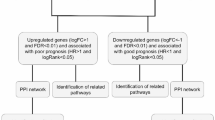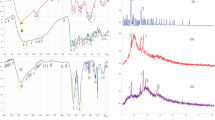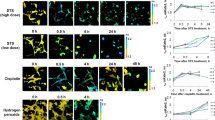Abstract
Colorectal cancer cells exhibit limited cytotoxicity towards Tiazofurin, a pro-drug metabolized by cytosolic nicotinamide mononucleotide adenylyltransferase2 (NMNAT2) to thiazole-4-carboxamide adenine dinucleotide, a potent inhibitor of inosine 5′-monophosphate dehydrogenase required for cellular guanylate synthesis. We tested the hypothesis that colorectal cancer cells that exhibit low levels of NMNAT2 and are refractory to Tiazofurin can be rendered sensitive to Tiazofurin by overexpressing NMNAT2. Transfection of hNMNAT2 resulted in a six- and threefold cytoplasmic overexpression in Caco2 and HT29 cell lines correlating with Tiazofurin-induced enhanced cell-kill. Folate receptors expressed on the cell surface of 30–50% colorectal carcinomas were exploited for cellular targeting with Tiazofurin encapsulated in folate-tethered nanoparticles. Our results indicated that in wild-type colorectal cancer cells, free Tiazofurin-induced EC50 cell-kill was 1500–2000 μM, which was reduced to 66–156 μM in hNMNAT2-overexpressed cells treated with Tiazofurin encapsulated in non-targeted nanoparticles. This efficacy was improved threefold by encapsulating Tiazofurin in folate-tethered nanoparticles to obtain an EC50 cell-kill of 22–59 μM, an equivalent of 100–300 mg m−2 (one-tenth of the approved dose of Tiazofurin in humans), which will result in minimal toxicity leading to cancer cell-kill. This proof-of-principle study suggests that resistance of colorectal cancer cell-kill to Tiazofurin can be overcome by sequentially overexpressing hNMNAT2 and then facilitating the uptake of Tiazofurin by folate-tethered nanoparticles, which enter cells via folate receptors.
This is a preview of subscription content, access via your institution
Access options
Subscribe to this journal
Receive 12 print issues and online access
$259.00 per year
only $21.58 per issue
Buy this article
- Purchase on SpringerLink
- Instant access to full article PDF
Prices may be subject to local taxes which are calculated during checkout






Similar content being viewed by others
Abbreviations
- FR:
-
folate receptors-α
- IMPDH:
-
inosine 5′-monophosphate dehydrogenase
- NMNAT:
-
nicotinamide 5′-mononucleotide adenylyltransferase
- TAD:
-
thiazole-4-carboxamide adenine dinucleotide
- TRMP:
-
tiazofurin 5′-monophosphate
- TR:
-
Tiazofurin (2-ß-D-ribofuranosylthiazole-4-carboxamide).
References
André T, Boni C, Mounedji-Boudiaf L, Navarro M, Tabernero J, Hickish T et al. Multicenter International Study of Oxaliplatin/5-Fluorouracil/Leucovorin in the Adjuvant Treatment of Colon Cancer (MOSAIC) Investigators. N Engl J Med 2004; 350: 2343–2351.
Wu C, Goldberg RM . Colorectal cancer in 2012: revisiting landmark trials and identifying new therapies. Nat Rev Clin Oncol 2013; 10: 71–72.
de Gramont A, Van Cutsem E, Schmoll HJ, Tabernero J, Clarke S, Moore MJ et al. Bevacizumab plus oxaliplatin-based chemotherapy as adjuvant treatment for colon cancer (AVANT): a phase 3 randomised controlled trial. Lancet Oncol 2012; 13: 1255–1233.
Arkenau HT, Arnold D, Cassidy J, Diaz-Rubio E, Douillard JY, Hochster H et al. Efficacy of oxaliplatin plus capecitabine or infusional fluorouracil/leucovorin in patients with metastatic colorectal cancer: a pooled analysis of randomized trials. J Clin Oncol 2008; 26: 5910–5917.
Emanuelli M, Carnevali F, Saccucci F, Pierella F, Amici A, Raffaelli N et al. Molecular cloning, chromosomal localization, tissue mRNA levels, bacterial expression, and enzymatic properties of human NMN adenylyltransferase. J Biol Chem 2001; 276: 406–412.
Schweiger M, Hennig K, Lerner F, Niere M, Hirsch-Kauffmann M, Specht T et al. Characterization of recombinant human nicotinamide mononucleotide adenylyltransferase (NMNAT), a nuclear enzyme essential for NAD synthesis. FEBS Lett 2001; 492: 95–100.
Raffaelli N, Sorci L, Amici A, Emanuelli M, Mazzola F, Magni G . Identification of a novel human nicotinamide mononucleotide adenylyltransferase. Biochem Biophys Res Commun 2002; 297: 835–840.
Zhang X, Kurnasov OV, Karthikeyan S, Grishin NV, Osterman AL, Zhang H . Structural characterization of a human cytosolic NMN/NaMN adenylyltransferase and implication in human NAD biosynthesis. J Biol Chem 2003; 278: 13503–13511.
Yalowitz JA, Xiao S, Biju MP, Antony AC, Cummings OW, Deeg MA et al. Characterization of human brain nicotinamide 5′-mononucleotide adenylyltransferase-2 and expression in human pancreas. Biochem J 2004; 377: 317–326.
Berger F, Lau C, Dahlmann M, Ziegler M . Subcellular compartmentation and differential catalytic properties of the three human nicotinamide mononucleotide adenylyltransferase isoforms. J Biol Chem 2005; 280: 36334–36341.
Cooney DA, Jayaram HN, Gebeyehu G, Betts CR, Kelley JA, Marquez VE et al. The conversion of 2-ß-D-ribofuranosylthiazole-4-carboxamide to an analog of NAD with potent IMP dehydrogenase-inhibitory properties. Biochem Pharmacol 1982; 31: 2133–2136.
Jayaram HN, Smith AL, Glazer RI, Johns DG, Cooney DA . Studies on the mechanism of action of 2-beta-D-ribofuranosylthiazole-4-carboxamide (NSC 286193)-II. Relationship between dose level and biochemical effects in P388 leukemia in vivo. Biochem Pharmacol 1982; 31: 3839–3845.
Jayaram HN . Biochemical mechanisms of resistance to tiazofurin. Adv Enzyme Regul 1985; 24: 67–89.
Jayaram HN, Zhen W, Gharehbaghi K . Biochemical consequences of resistance to tiazofurin in human myelogenous leukemic K562 cells. Cancer Res 1993; 53: 2344–2348.
Tricot GJ, Jayaram HN, Lapis E, Natsumeda Y, Nichols CR, Kneebone P et al. Biochemically directed therapy of leukemia with tiazofurin, a selective blocker of inosine 5'- phosphate dehydrogenase activity. Cancer Res 1989; 49: 3696–3701.
Wright DG, Boosalis MS, Waraska K, Oshry LJ, Weintraub LR, Vosburgh E . Tiazofurin effects on IMP-dehydrogenase activity and expression in the leukemia cells of patients with CML blast crisis. Anticancer Res 1996; 16: 3349–3351.
Grifantini M, Tiazofurine ICN . Pharmaceuticals. Curr Opin Investig Drugs 2000; 1: 257–262.
Maroun JA, Eisenhauer E, Cripps C, Maksymiuk A . Phase II study of tiazofurin in colorectal cancer: A National Cancer Institute of Canada study. Cancer Treat Rep 1987; 71: 1297–1298.
Jayaram HN, Lapis E, Tricot G, Kneebone P, Paulik E, Zhen W et al. Clinical pharmaco kinetic study of tiazofurin administered as a 1-hour infusion. Int J Cancer 1992; 51: 182–188.
Zhen W, Jayaram HN, Weber G . Antitumor activity of tiazofurin in human colon carcinoma HT-29. Cancer Invest 1992; 10: 505–511.
Lapis KY, Bocsi J, Tovari J, Bartha I, Timar J, Raso E . Antiinvasive effects of Tiazofurin on liver-metastatic human colon carcinoma xenografts. Anticancer Res 1996; 16: 3323–3331.
Ahluwalia GS, Jayaram HN, Plowman JP, Cooney DA, Johns DG . Studies on the mechanism of action of 2-ß-D-ribofuranosylthiazole-4-carboxamide-V. Factors governing the response of murine tumors to tiazofurin. Biochem Pharmacol 1984; 33: 1195–1203.
Lee RJ, Low PS . Folate-mediated tumor cell targeting of liposome-entrapped doxorubicin in vitro. Biochim Biophys Acta 1995; 1233: 134–144.
Zhang Y, Guo L, Roeske RW, Antony AC, Jayaram HN . Pteroyl-γ-glutamate-cysteine synthesis and its application in folate receptor-mediated cancer cell targeting using folate-tethered liposomes. Anal Biochem 2004; 332: 168–177.
Xiang G, Wu J, Lu Y, Liu Z, Lee RJ . Synthesis and evaluation of novel ligand for folate mediated targeting liposomes. Int J Pharm 2008; 356: 29–36.
Suzuki R, Takizawa T, Kuwata Y, Mutoh M, Ishiguro N, Utoguchi N et al. Effective anti-tumor activity of oxaliplatin encapsulated in transferrin-PEG-liposomes. Int J Pharm 2008; 346: 143–150.
Kalli KR, Oberg AL, Keeney GL, Christianson TJ, Low PS, Knutson KL et al. Folate receptor alpha as a tumor target in epithelial ovarian cancer. Gynecol Oncol 2008; 108: 619–626.
Shia J, Klimstra DS, Nitzkorski JR, Low PS, Gonen M, Landmann R et al. Immuno histochemical expression of folate receptor alpha in colorectal carcinoma: patterns and biological significance. Hum Pathol 2008; 39: 498–505.
D’Angelica M, Ammori J, Gonen M, Klimstra DS, Low PS, Murphy L et al. Folate receptor-α expression in resectable hepatic colorectal cancer metastases: patterns and significance. Modern Pathol 2011; 24: 1221–1228.
Xiao S, Tang YS, Khan RA, Zhang Y, Kusumanchi P, Stabler SP et al. Influence of physiologic folate deficiency on human papillomavirus type 16 (HPV16)-harboring human keratinocytes in vitro and in vivo. J Biol Chem 2012; 287: 12559–12577.
Antony A, Tang YS, Khan RA, Biju MP, Xiao X, Li QJ et al. Translational upregulation of folate receptors is mediated by homocysteine via RNA-heterogeneous nuclear ribonucleoprotein E1 interactions. J Clin Invest 2004; 113: 285–301.
Egan RW . Hydrophile-lipophile balance and critical micelle concentration as key factors influencing surfactant disruption of mitochondrial membranes. J Biol Chem 1976; 251: 4442–4447.
Gharehbaghi K, Sreenath A, Hao Z, Paull KD, Szekers T, Cooney DA et al. Comparison of biochemical parameters of benzamide riboside, a new inhibitor of IMP dehydrogenase, with tiazofurin and selenazofurin. Biochem Pharmacol 1994; 48: 1413–1419.
Nagai M, Natsumeda Y, Weber G . Proliferation-linked regulation of type II IMP dehydrogenase gene in human normal lymphocytes and HL-60 leukemic cells. Cancer Res 1992; 52: 258–261.
Franchetti P, Cappellacci L, Pasqualini M, Petrelli R, Jayaprakasan V, Jayaram HN et al. Synthesis, conformational analysis, and biological activity of new analogues of thiazole-4-carboxamide adenine dinucleotide (TAD) as IMP dehydrogenase inhibitors. Bioorg Med Chem 2005; 13: 2045–2053.
Ahluwalia GS, Cooney DA, Marquez VE, Jayaram HN, Johns DG . Studies on the mechanism of action of tiazofurin (2-beta-D-ribofuranosylthiazole-4-carboxamide). VI. Biochemical and pharmacological studies on the degradation of thiazole-4-carboxamide adenine dinucleotide (TAD). Biochem Pharmacol 1986; 35: 3783–3790.
Pillwein K, Schuchter K, Ressmann G, Gharehbaghi K, Knoflach A, Cermak B et al. Cytotoxicity, differentiating activity and metabolism of tiazofurin in human neuroblastoma cells. Int J Cancer 1993; 55: 92–95.
Gabizon AA . Pegylated liposomal doxorubicin: metamorphosis of an old drug into a new form of chemotherapy. Cancer Invest 2001; 19: 424–436.
Low PS, Antony AC . Folate receptor-targeted drugs for cancer and inflammatory diseases. Adv Drug Deliv Rev 2004; 56: 1055–1058.
Anderson RM, Bitterman KJ, Wood JG, Medvedik O, Cohen H, Lin SS et al. Manipulation of a nuclear NAD+ salvage pathway delays aging without altering steady-state NAD+ levels. Biol Chem 2002; 277: 18881–18890.
Guo X, Eans TRJ, Sumanth S, Armesilla AL, Darling JL, Schatzlein A et al. In vitro evaluation of cancer-specific NF-kB-CEA enhancer-promoter system for 5-fluorouracil prodrug gene therapy in colon cancer cells. Br J Cancer 2007; 97: 745–754.
Wang Y, Canine BF, Hatefi A . HSV-TK/GCV cancer suicide gene therapy by a designed recombinant multifunctional vector. Nanomedicine 2011; 7: 193–200.
Zhang J, Wei F, Wang H, Li H, Qiu W, Ren P et al. A novel oncolytic adenovirus expressing Escherichia coli cytosine deaminase exhibits potent antitumor effect on human solid tumors. Cancer Biother Radiopharm 2010; 25: 487–495.
Sun XL, Jayaram HN, Gharehbaghi K, Li QJ, Xiao X, Antony AC . Modulation of the cytotoxicity of 3′-azido-3′-deoxythymidine and methotrexate after transduction of folate receptor cDNA into human cervical carcinoma: Identification of a correlation between folate receptor expression and thymidine kinase activity. Cancer Res 1999; 59: 940–946.
Sega EL, Low PS . Tumor detection using folate receptor-targeted imaging agents. Cancer Metastasis Re 2008; 27: 655–664.
Acknowledgements
This work was supported by the United States Veterans Affairs Merit Review Award to Hiremagalur N Jayaram, PhD.
Author contributions
HNJ and ACA contributed to conception and design of the research, acquision of data, analysis and interpretation of data, drafting of the manuscript. PK, YZ, MBJ, NHJ, RAK and YT contributed to the acquisition of data, analysis and interpretation of data and final approval of the manuscript.
Author information
Authors and Affiliations
Corresponding author
Ethics declarations
Competing interests
A provisional patent application based on this work was filed by the technology transfer program of the United States Department of Veteran Affairs, Washington, DC for Drs Hiremagalur N Jayaram, Asok C Antony and Praveen Kusumanchi. The remaining authors, Drs Yonghua Zhang, Mehul B Jani, Nagesh H Jayaram, Rehana A Khan and Yingsheng Tang declare no conflict of interest.
Rights and permissions
About this article
Cite this article
Kusumanchi, P., Zhang, Y., Jani, M. et al. Nicotinamide mononucleotide adenylyltransferase2 overexpression enhances colorectal cancer cell-kill by Tiazofurin. Cancer Gene Ther 20, 403–412 (2013). https://doi.org/10.1038/cgt.2013.33
Received:
Accepted:
Published:
Issue date:
DOI: https://doi.org/10.1038/cgt.2013.33



